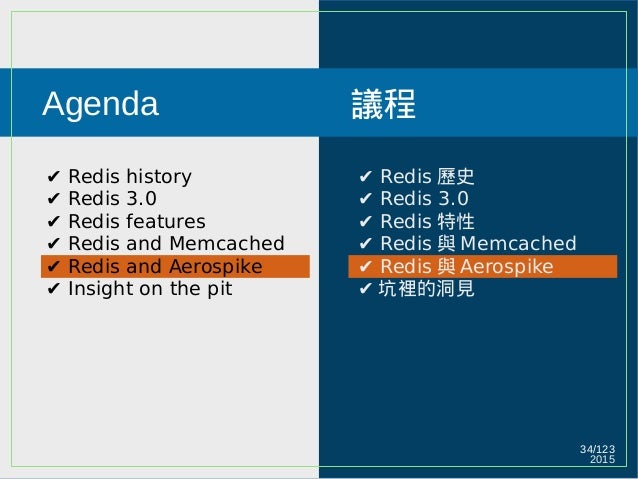Is Aerospike Better Than Redis
- Why Choose ScaleOut Over Redis. Can’t risk serving stale data? Tired of configuration hassles? ScaleOut StateServer® offers a better combination of features, always serves the latest data, is easy to manage, and has been battle-tested for more than a decade — with world-class support for the enterprise.
- Redis, another step on the road 1. Redis, another step on the road 2015-05-15 Ant yftzeng@gmail.com 2. 2015 2/123 Agenda Redis history Redis 3.0 Redis features Redis and Memcached Redis and Aerospike Insight on the pit 議程 Redis 歷史 Redis 3.0 Redis 特性 Redis 與 Memcached Redis 與 Aerospike 坑裡的洞見.
Most engine designs we're now using are an evolution of the space race era in one form or another, from the times when financing research in rocket engine / nozzle design wasn't such an issue. Linear spike fundamentally changes rocket design, for one engine support structure, and would as such require a revolution in engineering if someone expects it on the cheap. Steady evolution simply isn't good enough, the changes required are too big.So either rocket engine research & development would get a huge injection of money from somewhere, or we reach some engineering breakthrough that doesn't require so much of it, like maybe more reliable engineering simulators (, but not enough). Short of that, designing, building and testing cycles are simply too expensive. Engineering side of it is challenging, but no engineer will ever tell you it's impossible.

$begingroup$ Welcome to Stack Exchange! Answering questions here is a little different than on other sites. Can you add more and explain the key points in the link that are relevant? In SE, answers should be able to stand on their own after links break, so link-only answers are not considered helpful. Also, 'We should see this in use this year.'
Nov 17, 2015 Cassandra vs MongoDB vs CouchDB vs Redis vs Riak vs HBase vs Couchbase vs OrientDB vs Aerospike vs Neo4j vs Hypertable vs ElasticSearch vs Accumulo vs VoltDB vs Scalaris vs RethinkDB comparison. Java November 17, 2015 Leave a comment (Yes it’s a long title, since people kept asking me to write about this and that too 🙂 I do when it has a.
Sounds intriguing; why do you think so? Can you add some specific information here why you believe it will happen so soon?
$endgroup$–May 31 '18 at 5:12.
UPDATE: read our followup postTwo months ago, Amazon launched its EBS Provisioned IOPS (PIOPS) for running high performance databases in the cloud, and introduced EBS-Optimized instances to deliver dedicated throughput between EC2 and EBS. As the provider of the service, we wanted to know whether the PIOPS EBS with EBS-Optimized instances would really perform better than Standard EBS with non-optimized instances for Redis. Note – recently, Amazon released their new RDS Provisioned IOPS. However, it is not applicable to Redis and is therefore not addressed in this post.Running Redis on AWS has been for Redis users, mainly due to EBS’ slow and unpredictable network and I/O throughput.
Though Redis is a pure in-memory datastore system and serves everything from RAM, it also has two for better durability: AOF (Append Only File) and Snapshotting. These mechanisms are very efficient when interfacing with persistent storage, as they only use sequential writes with no seek time.

As a result, Redis can run pretty well with data-persistence even on non-SSD hardware.That being said, we decided to conduct some benchmarks for Amazon’s EBS PIOPS because slow storage devices can still be very painful for Redis. We see this when the AOF “fsync every second” policy blocks an entire Redis operation due to slow disk I/O. In addition, background saving for point-in-time snapshots or AOF rewrites takes longer, and therefore more memory is used for copy-on-write — leaving less memory available for your app. You may have seen the from comparing the performance of PIOPS EBS vs.
Standard EBS using EBS-Optimized and non-Optimized instances. While their tests were interesting, we thought we’d dig a little deeper and examine whether the performance of a simple Redis application is influenced by different storage architecture. Therefore, we were very specific and only tested the performance of sequential writes, ignoring other scenarios like random read/write and sequential read.For our benchmark, we also reviewed cost implications, and used what we believe is a more optimal performance configuration of Standard EBS (1 x 1TB EBS volume vs. 10 x 100 GB RAID0 EBS, per a very educational blog about by Adrian Cockcroft from Netflix).
So, without further ado, here are the details of our testsBenchmark Setup We used the following setup: PIOPS EBS with Optimized-Instance (i.e. M2.4xlarge with EBS-Optimized attribute set to true) vs. Standard EBS with non-Optimized Instance (m2.4xlarge with EBS-Optimized attribute set to false). We also tested another setup in which we compared PIOPS EBS vs. Standard EBS on a non Optimized-Instance (m2.2xlarge). Our intention was to see whether AWS users who cannot use the EBS Optimized-Instance for various reasons (such as cost) can get benefit from the new PIOPS EBS. Those results were very similar to the setup described above.
For all tests, we used 2 x m1.xlarge instances that run our memtierbenchmark load generation tool (memtierbenchmark is an advanced load generator tool we developed for testing Redis and Memcached datastores, which we will soon share in our account). We ran 8 tests on each configuration to simulate a Redis application, then ran each of these tests 3 times and calculated the average results. Our tests combinations included:. 100 and 500 connections on each load-generator machine (200 and 1000 connections total). 100B and 1KB object size. 50%/50% read/write scenario, and 100% write scenario (for imposing load on EBS).
Is Aerospike Better Than Redistricting

RAID SetupRAID software: MDMD version: v3.2.5RAID configurationmdadm –create ebs-stripe –name ebs-stripe –homehost any –raid-devices 2 /dev/xvdj /dev/xvdk –chunk 256 –level 0 #where xvdj and xvdk are each 1TB ebs volumeBenchmark Results Note – we have chosen to show the results from the 1KB object size tests, which impose higher load on the EBS. RPS (Requests Per Seconds) Latency The RPS and Latency results aggregated from our two memteirbenchmark tools are shown above.
Our latency tests take into account the network round-trip, the Redis processing time, and the time it takes for the memtierbenchmark tool to parse the result. As you can see, RPS and latency are approximately the same on all tests, though there are some differences which might be due to the fluctuations in the AWS infrastructure during the test time. Needless to say, Redis runs better with fewer disk accesses. IostatsThe results above are taken from iostats commands executed while the tests were running (here’s a useful that explains how to interpret Linux iostats). We ran iostats every 2.5 seconds and aggregated results from both EBS volumes.
These charts only present relevant performance parameters for Redis — “read” parameters were not presented as they were constantly zero during these tests. As you can see, except from few glitches here and there, iostats show approximately the same results for both EBS configurations. Set-up cost As mentioned earlier, we wanted to understand the cost implications of the Standard vs. PIOPS EBS options, so we compared the monthly setup costs using Amazon EC2 on-demand prices in us-east-1 (N.